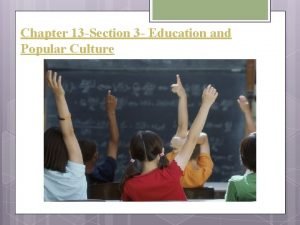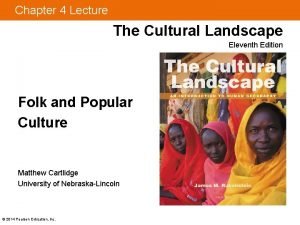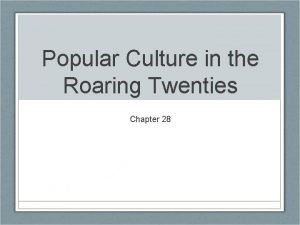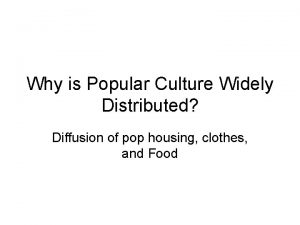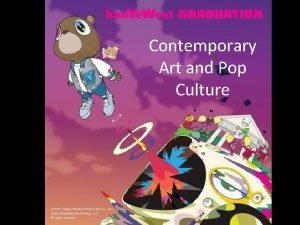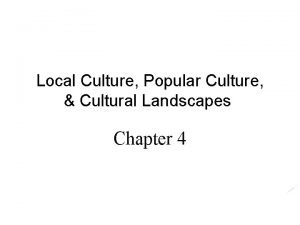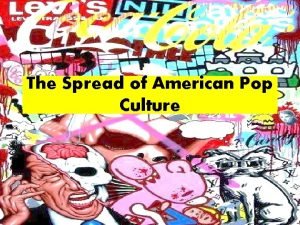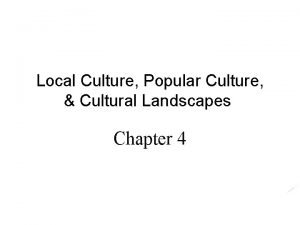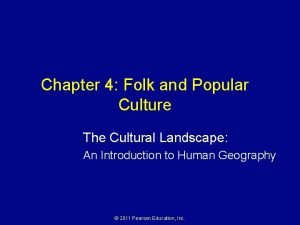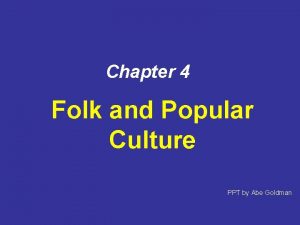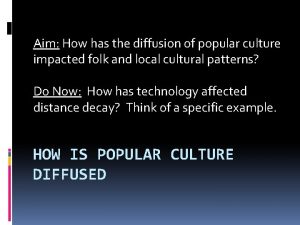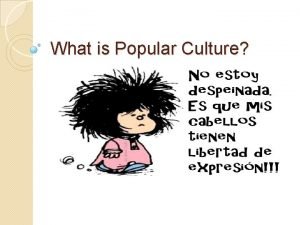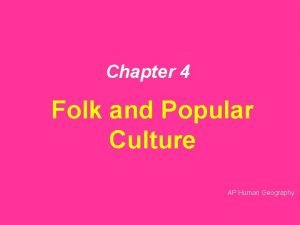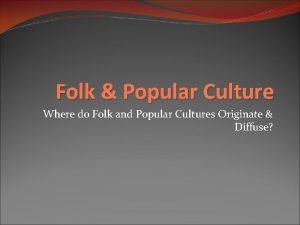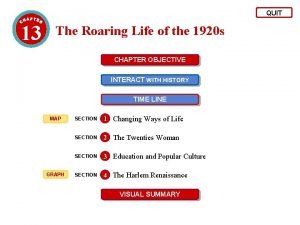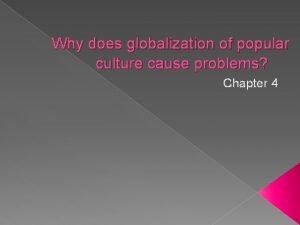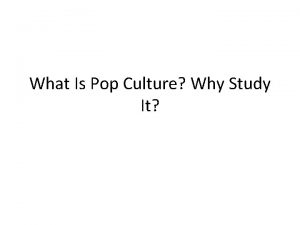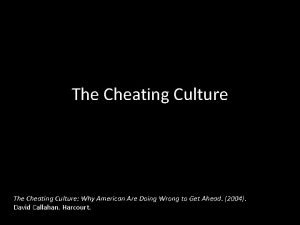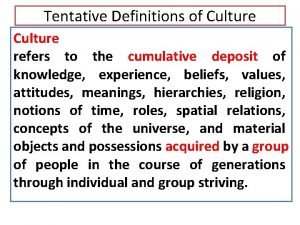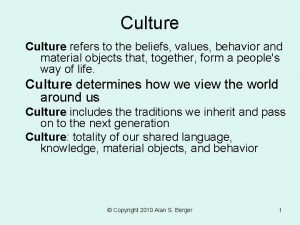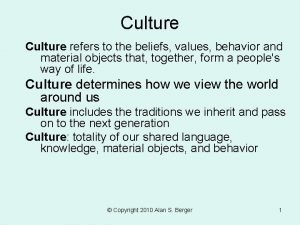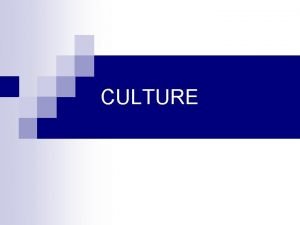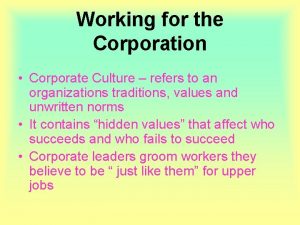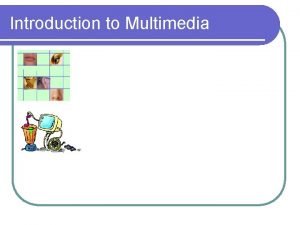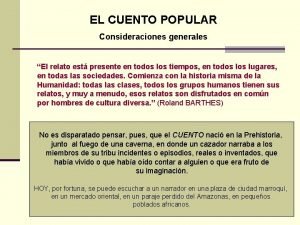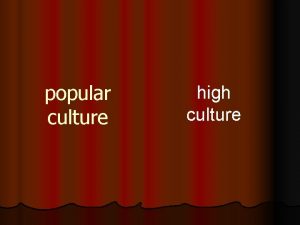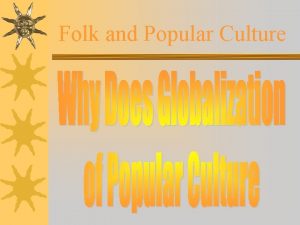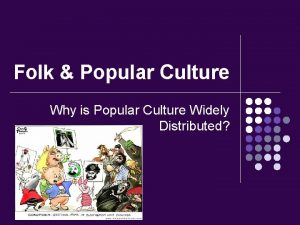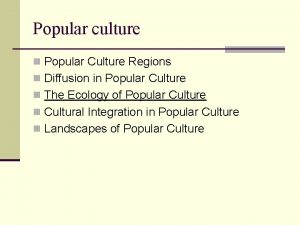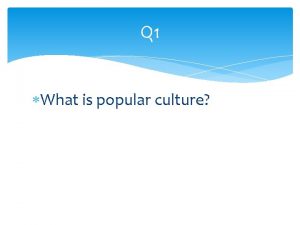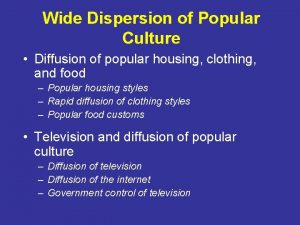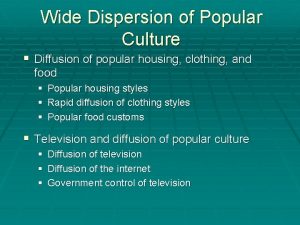Q 1 What is popular culture Refers to












































































- Slides: 76

Q 1 • What is popular culture?

• Refers to cultural products produced for sale to the mass of ordinary people. These involve mass produced standardized short -lived products of no lasting value

Q 2 • What is folk culture?

• Refers to the culture created by local communities and is rooted in the experiences, customs and beliefs of ordinary people

Q 3 • What is a subculture?

• Is a smaller culture held by a group of people within the main culture of society which is in some ways different from the main culture but with many aspects in common. Examples include CHAVS etc

Q 4 • What are the four different types of identity?

• Individual or personal identity • Social identity • Collective identity • Multiple identity

Q 5 • What is a stigmatised identity?

• Refers to an identity that is in some way undesirable or demeaning and excludes people from full acceptance in society

Q 6 • What is primary socialisation?

• Refers to the taught values and norms of society which construct a individual’s identity and is carried out by family members such as parents

Q 7 • What is secondary socialisation?

• Refers to the socialisation which takes place outside the family and occurs instead in schools, media, friends and religious institutions

Q 8 • What is global culture?

• Refers to the way cultures in different societies in different countries of the world have been increasingly alike

Q 9 • Identify the 5 distinct areas of secondary socialisation

• The education system • Peer group • Workplace • The mass media • Religious institutions

Q 10 • What does Jenkins (1996) argue about the socialisation and the social construction of self and identity?

• Jenkins argues that identities are formed in the socialisation process

Q 11 • What are structural approaches?

• Structural approaches see identities as formed by the wider social forces making up the structure of society.

Q 12 • Identify three structural approaches

• Functionalism, feminism & Marxism

Q 13 • What are social action approaches?

• Social action approaches see individuals having control over the formation of their identities, rather than identities being formed by the social structures

Q 14 • How does Mead see the identities of individuals?

• Mead sees the identities of individuals as being in a state of flux. This is because they are changing and developing all the time as they go through daily life.

Q 15 • What did Goffman mean by ‘impression management’?

Goffman argues people try to project a particular impressions of themselves. They do this by putting on dramatic performances or ‘shows’ in order to influence or manipulate the way others see them.

Q 16 • Identify one criticism of structural approaches and one criticism of social action approaches

• Criticisms of structural approaches fail to recognise: free will; choice; challenges; disobedience • Criticisms of social action approaches include: not enough emphasis is placed on power inequalities; power of social institutions; social etiquette; need to work/earn money;

Q 17 • What is structuration?

• Structuration sees the social structure and society’s culture making it possible for individuals to form their identities. It recognises that while identities are partly formed by individual choice, that choice is limited by the social structure and the culture in which people live.

Q 18 • What does Bourdieu mean by ‘habitus’?

• Habitus is the cultural possessed by a social class, into which people are socialized, which influences their cultural choices and tastes

Q 19 • What does Bourdieu mean by cultural capital?

• Cultural capital is the education, knowledge, language, attitudes and values possessed by the upper and upper middle-class

Q 20 • Identify one key aspect of the new working-class

Q 20 • Home-centred lifestyle, with no involvement with neighbours and wider community • Work is for making money not friends or identity • No loyalty to their class • Women more likely to be in paid employment

Q 21 • What type of approach is Cooley’s? • What did he mean by the concept of ‘looking-glass self’? • 1 mark for each point

Answer • Social action approach • The ‘looking-glass self’ is the idea that our image of ourselves is reflected back to us (like a mirror) in the view of others

Question • What type of approach is feminism? • What might feminists argue shapes our identities? • 1 mark for each point

Answer • Structural • Our identities are shaped by wider social forces such as socialisation which then form our identities. Consequently the individual has little control over how their identities are formed

Question • What term did Bourdieu come up with when referring to the cultural framework and set of ideas possessed by a social class, into which people are socialised, initially by their families and which ultimately influence their cultural tastes and choices? • 2 marks

Answer • Habitus

Question • According to Bourdieu which has the greater cultural capital, low or high culture? And which social group tends to have it? • 1 mark for each point

Answer • High culture • Dominant or ruling-class

Question • Future time orientation and deferred gratification are two ideas which separate the middle-class from the working-class. 1. What are future time orientation and deferred gratification? 2. Which of the two social-class identified in the question have the above?

Answer • Planning for the future • Putting off today’s pleasures for tomorrow’s gains • Middle-class

Question • Which social-class has the following: 1. Men are seen as breadwinners, women mainly housewives 2. Getting a job with a skill and earning money, far more important than education and qualifications 3. A strong commitment to old Labour Party

Answer • Traditional working class

Question • Define gender identity and provide one example

Answer • Refers to how people see themselves and how others see them in terms of their gender roles and biological sex

Question • In relation to gender and identity what did Mead (2001) uncover?

Answer • She found from studying tribe in New Guinea that masculine and feminine characteristics are not based on biological differences but are a reflection of cultural conditioning within different societies. Therefore these differences are seen to be socially constructed.

Question • What did Connell (1995) mean by the term ‘hegemonic identity’?

Answer • Hegemonic identity is one that is so dominant that it makes if difficult for individuals to assert different identities

Question • What does the statement ‘the social construction of hegemonic gender identities through primary socialization

Answer • This means parents and relatives tend to hold stereotyped views of typical characteristics of boys and girls which are used as norms when socialising their children

Question • While keeping the last question and answer in mind, what are the four process Oakley identified are evident during primary socialisation?

Answer • Manipulation • Canalization • Verbal appellations • Differential activity exposure

Question • What do you understand by the term new man?

• Is a man who is seen to be more caring, sharing, gentle, emotional etc

Question • Provide two examples of qualitative data

Answer • Participant and sometimes nonparticipant observations • Informal (unstructured) interviews • Open-ended questionnaires • Personal accounts like diaries & letters

Question • What is the Hawthorne effect?

Answer • Is where the presence of a researcher affects the behaviour of those groups/individuals being observed

Question • What is the survey population is social research?

Answer • Is the whole group being studied

Question • What is a sample in social research?

Answer • A sample is a smaller representative group drawn from the sample population

Question • What is a quota sample?

Answer • Where people are selected who fit in a certain category, for example a social researcher might want to study people over the age of 45

• What is validity in social research?

• Where a true or accurate picture is created about something from the acquired data
 Chapter 4 folk and popular culture
Chapter 4 folk and popular culture Homework due today
Homework due today Folk culture and popular culture venn diagram
Folk culture and popular culture venn diagram Chapter 13 section 3 education and popular culture
Chapter 13 section 3 education and popular culture Why is access to folk and popular culture unequal
Why is access to folk and popular culture unequal Chapter 28 popular culture in the roaring twenties
Chapter 28 popular culture in the roaring twenties поп музика
поп музика Rapid diffusion of popular culture
Rapid diffusion of popular culture Ethnocentrism examples
Ethnocentrism examples Popular culture themes
Popular culture themes What is popular culture
What is popular culture How do the origins of folk and popular culture differ
How do the origins of folk and popular culture differ American culture collage
American culture collage Habit ap human geography
Habit ap human geography Features of popular culture
Features of popular culture Notes on deconstructing the popular
Notes on deconstructing the popular Universalization of popular culture
Universalization of popular culture What is assimilation
What is assimilation Daily life and popular culture in the 1950s
Daily life and popular culture in the 1950s Folk and popular culture
Folk and popular culture Popular culture ppt
Popular culture ppt Learning english through social issues writing
Learning english through social issues writing Popular culture diffusion
Popular culture diffusion Popular culture definition
Popular culture definition Media pop culture
Media pop culture Popular culture images
Popular culture images Example of folk culture ap human geography
Example of folk culture ap human geography Examples of folk and popular culture
Examples of folk and popular culture What is popular culture
What is popular culture 1920 popular culture
1920 popular culture Why does globalization of popular culture cause problems
Why does globalization of popular culture cause problems Chapter 19 section 1 postwar america
Chapter 19 section 1 postwar america Education and popular culture lesson 5 answer key
Education and popular culture lesson 5 answer key What is popular culture
What is popular culture Folk and popular culture
Folk and popular culture How do the origins of folk and popular culture differ
How do the origins of folk and popular culture differ Global cheating culture refers to
Global cheating culture refers to Culture is commulative
Culture is commulative Beliefs values behavior and material objects
Beliefs values behavior and material objects Culture refers to:
Culture refers to: Latipso definition
Latipso definition Corporate culture refers to
Corporate culture refers to Surface culture deep culture and esol
Surface culture deep culture and esol Stroke culture method
Stroke culture method Batch culture vs continuous culture
Batch culture vs continuous culture Carpet culture method
Carpet culture method Sub culture vs counter culture
Sub culture vs counter culture Describe lawn culture and surface plating
Describe lawn culture and surface plating Sociologists define a symbol as
Sociologists define a symbol as Individualistic culture vs. collectivist culture
Individualistic culture vs. collectivist culture Anaerobic medium
Anaerobic medium Quality culture vs traditional culture
Quality culture vs traditional culture Difference between american and indian culture
Difference between american and indian culture Batch culture vs continuous culture
Batch culture vs continuous culture Inert organizational culture
Inert organizational culture What is a multimedia product
What is a multimedia product Fast food is very popular and saves time
Fast food is very popular and saves time Popular hris
Popular hris Que es el cuento y su origen
Que es el cuento y su origen Escritura popular
Escritura popular Mengapa artikel opini ditulis dengan gaya ilmiah populer
Mengapa artikel opini ditulis dengan gaya ilmiah populer Soberania popular
Soberania popular Palavras convergentes
Palavras convergentes Popular sovereignty
Popular sovereignty Khong wong country
Khong wong country Principles of popular sovereignty
Principles of popular sovereignty Drum printer definition
Drum printer definition Popular sovereignty
Popular sovereignty Popular sovereignty
Popular sovereignty Popular diocesano
Popular diocesano Thai pop music
Thai pop music Popular case tools
Popular case tools Tea is popular many people in the world
Tea is popular many people in the world Canto popular uruguayo origen
Canto popular uruguayo origen How to do quick sort
How to do quick sort Estereótipo popular ergonomia
Estereótipo popular ergonomia Most popular lan
Most popular lan



